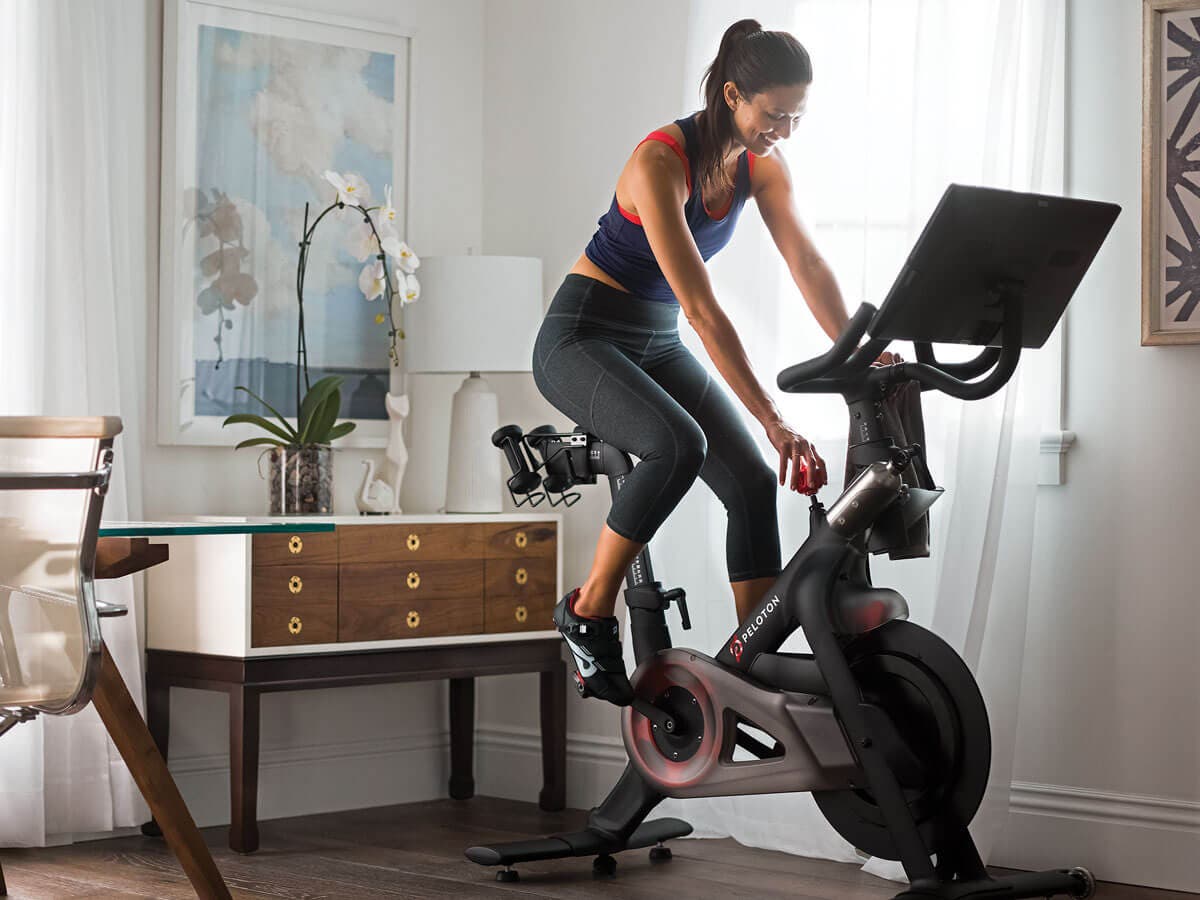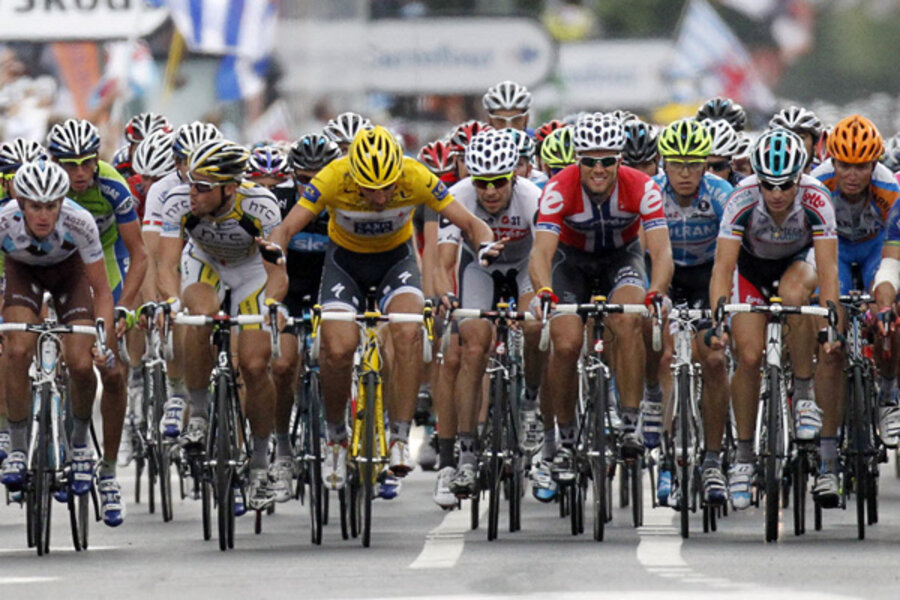What is a Peloton and Why is it Important in Cycling?
In the world of cycling, the concept of a peloton is often misunderstood. So, what is a cycling peloton? A peloton refers to a group of riders who ride together in a close formation, often in a professional or competitive setting. The term “peloton” originated in Europe, where it was used to describe the main group of riders in a race. Today, the term is used to describe any group of riders who ride together, whether it’s in a professional race or a casual group ride.
The importance of a peloton in cycling cannot be overstated. When riders form a peloton, they can conserve energy by drafting behind one another, reducing wind resistance and allowing them to maintain a faster pace. This is especially important in professional racing, where every second counts. Additionally, riding in a peloton provides an added layer of safety, as riders can look out for one another and respond to potential hazards more quickly.
In recreational cycling, a peloton can be just as beneficial. Riding with a group can be a great motivator, as riders can push and encourage one another to ride faster and farther. It’s also a great way to meet new people and make friends who share a passion for cycling. Whether you’re a seasoned pro or just starting out, understanding what a cycling peloton is and how it works can enhance your overall cycling experience.
How to Ride Safely in a Peloton: Essential Tips and Strategies
Riding in a peloton can be an exhilarating experience, but it also requires a high level of skill and attention to safety. When riders are packed tightly together, the risk of accidents increases, making it essential to know how to ride safely and efficiently in a peloton. Here are some essential tips and strategies to help you do just that.
Positioning is key when riding in a peloton. Ride near the front of the group, but not at the very front, as this will give you more time to react to any sudden movements or obstacles. Keep a safe distance from the rider in front of you, about one to two bike lengths, and avoid overlapping wheels.
Communication is critical in a peloton. Use verbal cues, such as “hole” or “car up,” to alert other riders to potential hazards. Also, use hand signals to indicate when you’re slowing down or changing direction. This will help prevent accidents and keep the group moving smoothly.
Situational awareness is also crucial when riding in a peloton. Keep an eye on the road ahead, watching for potholes, gravel, and other obstacles that could cause you to lose control. Anticipate the actions of other riders and be prepared to react quickly to any changes in the group’s dynamics.
Finally, always be aware of your own limitations and fitness level. Don’t try to ride at a pace that’s beyond your capabilities, as this can put you and others at risk. Take regular breaks to rest and rehydrate, and don’t be afraid to drop back to a slower group if you’re feeling fatigued.
The Science Behind Peloton Dynamics: Understanding Aerodynamics and Drafting
When it comes to cycling, aerodynamics play a crucial role in a rider’s performance. In a peloton, aerodynamics and drafting come together to create a unique dynamic that can significantly impact a rider’s speed and energy expenditure. But what exactly is drafting, and how does it work?
Drafting, also known as slipstreaming, is the practice of riding closely behind another rider to reduce wind resistance. When a rider is in front, they create a buffer of air that shields the riders behind them from the wind. This reduces the energy required to maintain a certain speed, allowing riders to conserve energy and ride more efficiently.
The science behind drafting is rooted in aerodynamics. When a rider is alone, they create a significant amount of drag, which slows them down. However, when riders are grouped together, the drag is reduced, allowing them to maintain a faster pace. This is because the air displaced by the lead rider creates a buffer zone that reduces the wind resistance for the riders behind.
In a peloton, drafting is crucial for success. By riding in a tight formation, riders can reduce their energy expenditure by up to 30%, allowing them to maintain a faster pace for longer periods. This is especially important in professional racing, where every second counts. However, drafting is not limited to professional riders; recreational cyclists can also benefit from riding in a peloton and taking advantage of the aerodynamic benefits.
Understanding the science behind peloton dynamics is essential for any cyclist looking to improve their performance. By grasping the concepts of aerodynamics and drafting, riders can optimize their position in the peloton, conserve energy, and ride more efficiently. Whether you’re a seasoned pro or just starting out, understanding the science behind a cycling peloton can take your riding to the next level.
The Role of Teamwork in a Peloton: Working Together for Success
In a peloton, teamwork is essential for achieving success. Whether it’s protecting the leader, chasing down breaks, or working together to reel in a rival team, riders must work together to achieve common goals. This requires a high level of communication, trust, and coordination among team members.
In professional cycling, teamwork is crucial for winning races. Teams employ various tactics, such as setting a pace, blocking, and launching attacks, to gain an advantage over their rivals. Each rider has a specific role to play, and they must work together seamlessly to execute their strategy.
But teamwork is not limited to professional cycling. In recreational group rides, riders can also benefit from working together. By sharing the workload, riders can conserve energy and maintain a faster pace. This is especially important on long rides, where fatigue can set in quickly.
One of the key aspects of teamwork in a peloton is communication. Riders must be able to communicate effectively to coordinate their efforts and respond to changes in the race or ride. This includes verbal cues, such as calling out obstacles or signaling a turn, as well as non-verbal cues, such as body language and hand signals.
Trust is also essential in a peloton. Riders must be able to trust each other to hold their line, maintain a safe distance, and not make sudden movements that could cause a crash. This trust is built through experience and communication, and it’s essential for maintaining a safe and efficient peloton.
Finally, coordination is critical in a peloton. Riders must be able to coordinate their efforts to achieve their goals. This includes working together to set a pace, chase down breaks, and protect the leader. By coordinating their efforts, riders can achieve more together than they could alone.
In a cycling peloton, teamwork is the key to success. By working together, riders can achieve their goals, conserve energy, and maintain a faster pace. Whether you’re a professional cyclist or a recreational rider, understanding the importance of teamwork in a peloton can take your riding to the next level.
Peloton Etiquette: Rules of the Road for Group Cycling
When riding in a peloton, there are certain unwritten rules that riders must follow to ensure a safe and enjoyable experience for everyone. These rules, known as peloton etiquette, are essential for maintaining a cohesive and efficient group ride.
One of the most important rules of peloton etiquette is rotating. In a rotating peloton, riders take turns at the front, setting the pace and shielding the others from the wind. This rotation is crucial for sharing the workload and conserving energy. Riders should rotate regularly, usually every 10-20 minutes, to avoid fatigue and maintain a steady pace.
Another key aspect of peloton etiquette is pulling. When a rider is at the front of the peloton, they are responsible for setting the pace and maintaining the group’s speed. This requires a high level of fitness and endurance, as well as the ability to read the road and anticipate changes in the terrain. Riders should only pull for as long as they are comfortable, and then rotate to the back of the group to recover.
Communication is also essential in a peloton. Riders should communicate regularly to alert others to obstacles, changes in the road, and other hazards. This includes verbal cues, such as calling out “hole” or “car back,” as well as non-verbal cues, such as pointing to obstacles or using hand signals.
In addition to these rules, there are several other guidelines that riders should follow to maintain a safe and efficient peloton. These include riding in a straight line, avoiding sudden movements, and keeping a safe distance from other riders. By following these rules, riders can ensure a safe and enjoyable experience for everyone in the group.
Finally, peloton etiquette also involves respecting the other riders in the group. This includes being mindful of others’ fitness levels and abilities, and not pushing the pace too hard. It also involves being courteous and considerate, such as not cutting off other riders or blocking their path.
By following these rules of peloton etiquette, riders can ensure a safe, efficient, and enjoyable group ride. Whether you’re a seasoned pro or a recreational rider, understanding the unwritten rules of a cycling peloton is essential for getting the most out of your ride.
Famous Pelotons in Cycling History: Iconic Moments and Riders
Cycling has a rich history, filled with iconic moments and legendary riders who have shaped the sport. One of the most fascinating aspects of cycling history is the peloton, which has played a crucial role in many of the sport’s most memorable moments.
One of the most famous pelotons in cycling history is the 1986 Tour de France, where Greg LeMond and Bernard Hinault formed an unlikely alliance to take on the dominant La Vie Claire team. This peloton, known as the “Badger and the Bird,” is still talked about today, and its legacy continues to inspire riders around the world.
Another iconic peloton is the 1992 Olympic Games, where the US cycling team, led by Lance Armstrong, rode to a stunning victory in the team time trial. This peloton, which included riders like Steve Hegg and Bob Mionske, was known for its precision and teamwork, and its victory marked a turning point in American cycling.
In addition to these iconic moments, there have been many legendary riders who have made their mark on the peloton. Riders like Eddy Merckx, Jacques Anquetil, and Miguel Indurain are just a few examples of cyclists who have dominated the peloton and left an indelible mark on the sport.
One of the most famous pelotons of all time is the 2012 Tour de France, where Bradley Wiggins and his Sky teammates rode to a dominant victory. This peloton, known for its precision and teamwork, was hailed as one of the greatest in cycling history, and its legacy continues to inspire riders around the world.
These iconic moments and riders have helped shape the sport of cycling, and their legacy continues to inspire riders around the world. Whether you’re a professional cyclist or a recreational rider, understanding the history of the peloton is essential for appreciating the sport.
By studying the tactics and strategies of these famous pelotons, riders can gain valuable insights into how to ride more efficiently and effectively. Whether you’re looking to improve your performance or simply enjoy the thrill of group riding, understanding the history of the peloton is an essential part of the cycling experience.
Training with a Peloton: How to Improve Your Cycling Skills
Training with a peloton is an excellent way to improve your cycling skills, whether you’re a seasoned pro or a recreational rider. Riding with a group can help you develop your technique, increase your endurance, and boost your confidence on the bike.
One of the most effective ways to train with a peloton is to focus on cornering drills. Cornering is a critical skill in cycling, and practicing with a group can help you develop the technique and confidence you need to take corners smoothly and efficiently. Try setting up a course with tight corners and practicing with your peloton, taking turns leading and following to improve your skills.
Climbing is another essential skill in cycling, and training with a peloton can help you develop the strength and endurance you need to tackle even the toughest hills. Try incorporating hill repeats into your training, with each rider taking turns leading the group up the hill and then recovering at the back.
Sprinting is another critical skill in cycling, and training with a peloton can help you develop the speed and power you need to win sprints. Try setting up a course with a series of short sprints, with each rider taking turns leading the group and then recovering at the back.
In addition to these specific drills, training with a peloton can also help you develop your overall cycling skills, such as pace lining, drafting, and communication. By riding with a group, you can learn how to work together to achieve common goals, such as chasing down breaks or protecting the leader.
To get the most out of training with a peloton, it’s essential to focus on teamwork and communication. Make sure to communicate with your fellow riders about your pace, position, and intentions, and work together to achieve your goals. By doing so, you can develop your skills, increase your endurance, and have more fun on the bike.
Remember, training with a peloton is all about working together to achieve common goals. By focusing on teamwork, communication, and specific drills, you can improve your cycling skills and take your riding to the next level.
Joining a Peloton: Finding the Right Group Ride for You
Joining a peloton can be a daunting task, especially for new riders. However, with the right approach, you can find a group ride that suits your fitness level, riding style, and goals. In this article, we’ll provide guidance on how to find and join a peloton, including tips on researching local cycling clubs, assessing your fitness level, and preparing for group rides.
Researching Local Cycling Clubs
One of the best ways to find a peloton is to research local cycling clubs in your area. Look for clubs that cater to your fitness level, whether you’re a beginner or an experienced rider. Check their website, social media, or attend one of their group rides to get a feel for the club’s culture and dynamics.
Assessing Your Fitness Level
Before joining a peloton, it’s essential to assess your fitness level. Be honest with yourself about your current fitness level, and look for a group ride that matches your abilities. If you’re new to cycling, consider joining a beginner’s group ride or a spin class to build your endurance and confidence.
Preparing for Group Rides
Once you’ve found a peloton that suits your fitness level, it’s essential to prepare for group rides. Make sure your bike is in good working condition, and invest in the necessary safety gear, such as a helmet and reflective clothing. Also, familiarize yourself with the group’s rules and etiquette, such as rotating, pulling, and communicating within the group.
What to Expect from a Peloton
When joining a peloton, expect a dynamic and fast-paced ride. Be prepared to work together with other riders to achieve common goals, such as chasing down breaks or protecting the leader. Remember to communicate with your fellow riders, and be aware of your surroundings to ensure a safe and enjoyable ride.
In conclusion, joining a peloton can be a rewarding and challenging experience. By researching local cycling clubs, assessing your fitness level, and preparing for group rides, you can find a peloton that suits your needs and goals. Remember to always prioritize safety, communication, and teamwork to get the most out of your group ride experience.








